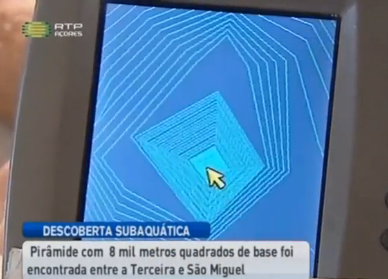Sailor Diocleciano Smith has discovered, based on bathymetry readings, a 60 meters high and 8000 meters wide underwater pyramid near the Bank De João de Castro, between the islands of Terceira and São Miguel. The mysterious building is around forty meters below water and aligned with the four cardinal compass directions, similar to the Great Pyramid of Giza.
Is this newly discovered underwater pyramid man-made or natural?
The discoverer doesn’t believe the pyramid is of natural origin. This matter is already being investigated with the support of the Portuguese Navy.
Are these the remains of the lost City of Atlantis?
Legends of an advanced prehistoric civilization know as Atlantis have been around since the beginning of history, but previously those who searched for it were divided whether or not it was located near the Azores, South America or elsewhere. From as far back as Plato it was suggested the original builders of the pyramids lived west of Gibraltar, but findings of Machu Picchu, and other curiosities in the Mediterranean, led people to believe it was on the other side of the Atlantic.
The Azores are a chain of nine volcanic islands in three main groups that are 930 miles west of Lisbon. They are above what is known as a geological triple junction where the North American, Eurasian, and African tectonic plates meet. They were recolonized in 1941, but artifacts have been found suggesting they had been previously inhabited. Those artifacts are thought to have predated Christ by a few thousand years, but the location of the pyramid has been below water for 20,000 years since the last ice age.
Legends also persisted of Atlantis, Sete Cidades (Kingdoms of the Seven Cities), the Terras of São Brandão, the Ilhas Aofortunadas (The Fortunate Islands), the Ilha da Brasil (the Island of Brasil), Antília, the Ilhas Azuis (Blue Islands), the Terra dos Bacalhaus (Land of Codfish), and charts appeared between 1351 and 1439 of several groupings of islands with various names. The first association between the modern island of Terceira and these stories, was that of the island of Brasil; it first appears as Insula de Brasil in the Venetian map of Andrea Bianco (1436), attached to one of the larger islands of a group of islands in the Atlantic.
Source: http://strangesounds.org/2013/09/atlantis-discovered-new-mysterious-underwater-pyramid-found-near-azores-island.html


Geen opmerkingen:
Een reactie posten